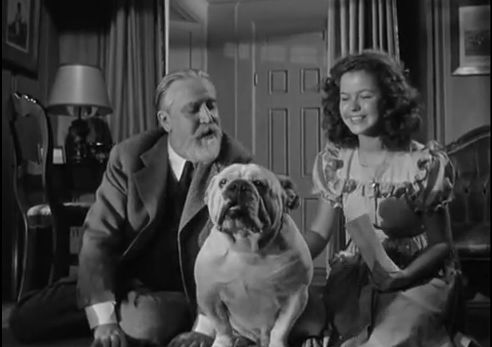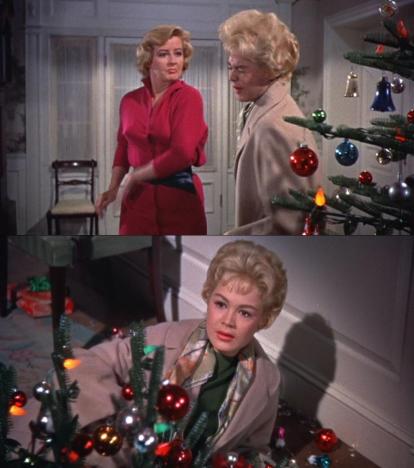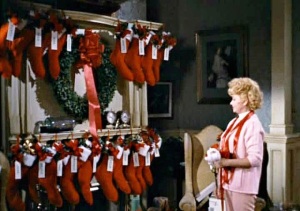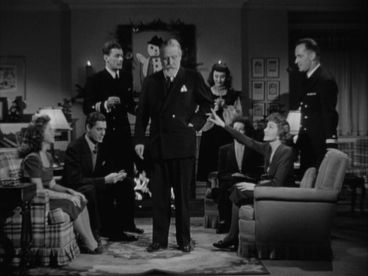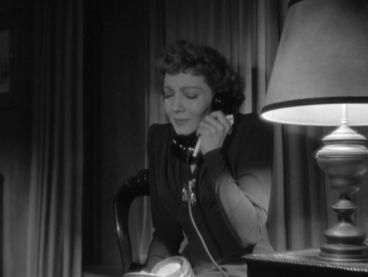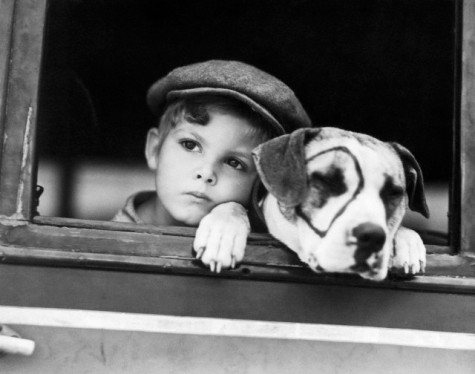
Dickie Moore with Pete the Pup in “Our Gang” in 1930. Moore said he didn’t enjoy the Hal Roach series because he didn’t feel he fit in
Dick Moore was searching for his “Rosebud.”
In “Citizen Kane,” a sled with the word “Rosebud” was the key to Charles Foster Kane’s lost childhood.
For Moore, early memories were a slew of movie scenes with James Cagney, Barbara Stanwyck and Paul Muni. He was the breadwinner for his out of work parents and went to school at a studio with other acting children.
His childhood was far a normal childhood of peanut butter and jelly sandwiches and playing at recess.
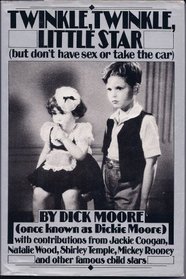 In Dick Moore’s book, “Twinkle, Twinkle, Little Star (but don’t have sex or take the car),” Moore shares his memories of performing as child star Dickie Moore and interviews 31 child actors to see how their experiences compare to his.
In Dick Moore’s book, “Twinkle, Twinkle, Little Star (but don’t have sex or take the car),” Moore shares his memories of performing as child star Dickie Moore and interviews 31 child actors to see how their experiences compare to his.
Some of these actors include Stymie of Our Gang, Roddy McDowall, Jane Powell, Jane Withers, Jackie Coogan, Edith Fellows, Natalie Wood, Jackie Cooper, Shirley Temple, Baby Peggy (Diana Serra Cary) and Peggy Ann Garner.
“All of us shared common lives and times, huge responsibilities and salaries that shriveled fathers’ egos,” Moore wrote
Some children wanted to go into show business, like Jane Withers. Others were pushed by their mothers (or saber-tooth tigers of the Hollywood jungle, according to Diana Cary), like Natalie Wood who sat on a director’s lap and sing him a song while a movie was location in Santa Rosa. And some happened by accident.
Moore was one of those accidents. A friend of a friend of his mother’s was a casting director who happened to stop by the Moore home. The studio pursued Mrs. Moore for Dickie to be in pictures. She said no, but finally gave in since Dickie’s father was out of work.
Dickie was 11 months old in his first film and playing John Barrymore as a baby.
Once Moore started acting, his father had an even more difficult time finding work. Employers assumed he made enough money and other parents brought their children to see Mr. Moore at work, hoping he could put them in films. Mr. Temple had the same problem.
The book explores how each child got into films, their home life, the affect on non-acting siblings and birthday parties.
Most of the young actors’ parties were opportunities for publicity and magazine photographers to put their faces in magazines.
“Everyone was posing. The whole business of publicity made parties seem synthetic. If you have a party, it’s supposed to just be with people,” said actor Gene Reynolds. “But most of our parties were stunt to get pictures in magazines so where is the fun in that?”
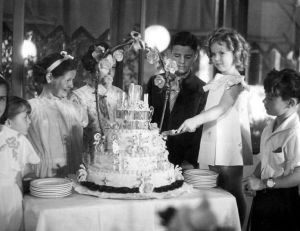
Shirley Temple cutting the cake at her birthday party in 1935.
Shirley Temple, the first child to carry a full weight picture on her own, would have three birthday parties each year: one with other child actors, one on set with the crew and one with her family.
“The parties were endless…Fox would have one for a large number of people I didn’t know, a lot of children I’d never seen in my life and would never seen again. And I was he hostess. It was kind of strange. I figured it was part of my job.”
Temple was also very isolated, as were many children. Moore’s parents allowed him freedom to play outside while others had no friends.
“Parents often discouraged their children from forming solid friendships because friends might tell each other about a part that was coming up and then, from the parents’ point of view, that wrong child would get the job,” Moore wrote.
Competition was high among child actors: Who could cry the best on cue, lying about ages to be younger and trying to look young, i.e. pigtails, short dresses.
Adult co-stars and their treatment to youngsters are discussed in the book. Marlene Dietrich was warm and friendly in “The Blue Angel,” Franchet Tone taught him how to play chess during “The Bride Wore Red” and Gary Cooper suggested what type of gun Moore should buy.
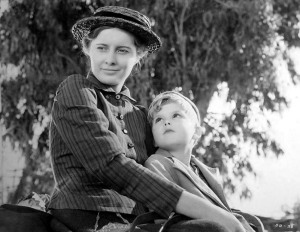
Moore with Barbara Stanwyck in “So Big”
But Moore’s favorite female adult star was Barbara Stanwyck was Moore’s favorite in “So Big.”
“Affectionate and demonstrative, she was easy to understand. She talked but didn’t fuss,” Moore wrote. “She was a direct and gracious woman, who seemed extremely interested in whatever interested me.”
Unanimously children liked working with Spencer Tracy because he would look right at you during a scene and listen to your lines.
Bobs Watson followed Tracy around during “Boys Town.”
“Often after a scene, he’d reach over and hug me and take me on his lap,” Watson said. “I felt like a little puppy. I would follow him around and stand close, hoping it would call me over and he often would.”
The two most disliked were W.C Fields and Wallace Beery.
“We did four long film together,” Jackie Cooper said about Beery. “They couldn’t find eight guys to carry his casket.”
Margaret O’Brien said he stole her lunch and Jane Powell said he would steal props off the set.
Two children got along with him: Darryl Hickman and Jackie Coogan.
Coogan’s father was a veteran in the business and it seems some of the tougher actors respected him because of this.
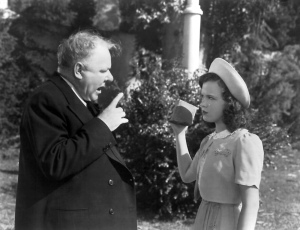
W.C. Fields and Gloria Jean in “Never Give a Sucker an Even Break.”
Fields notoriously disliked children and was known for getting drunk while filming. But Gloria Jean got along with him, because she tried to look out for him.
While the book tells some humorous and heartwarming stories, there is an underlying sadness. It’s like reading Romeo and Juliet and knowing the lovers die at the end of the play.
You know that for many of the child stars, their career would come to an end.
Children such as Jackie Coogan and Baby Peggy faced financial problems when their family member squandered or stole the millions they had earned for their family.
The biggest fear for a child star is to age, as many faded away when they got older. Moore was in magazines and on ice cream lids (similar to baseball cards) until he had scarlet fever and was away from the screen for a year, taking him back to the bottom.
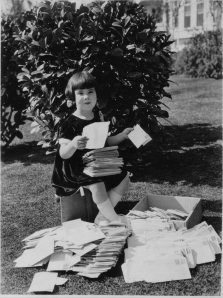
Baby Peggy (Diana Serra Cary) and her fan mail.
Baby Peggy felt she was a has-been at five.
Others like Jackie Cooper, Natalie Wood and Roddy McDowall went on to have a successful adult life.
But many child stars, even Jane Withers who loved acting, did not wish for their children to go into the business-they wanted them to have a normal childhood.
“They were wrong,” Roddy McDowall told Moore. “They were wrong to take us children and do that to our lives, to twist our environment in that way and then leave it for us to sort out.”
“Twinkle Twinkle Little Star..” is one of the best classic Hollywood books I have ever read about one of the most complicated and fascinating subjects.
If you can find it for a decent price, I highly suggest it.
This is part of my Children in Film blogathon. Read all of the entries here: https://cometoverhollywood.com/2013/05/24/children-in-films-blogathon-the-contributors/
Check out the Comet Over Hollywood Facebook page for the latest updates or follow on Twitter at @HollywoodComet.
Love what you read? Share it:
 1939 film:
1939 film:
 1939 film:
1939 film:  This week’s musical:
This week’s musical:







